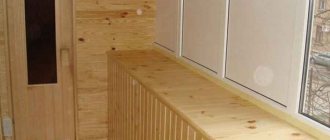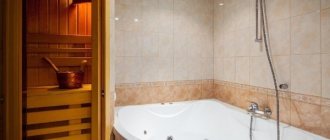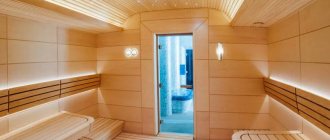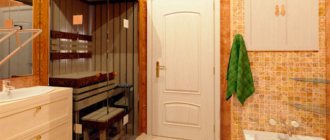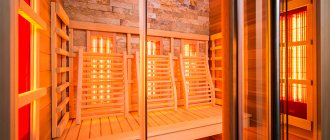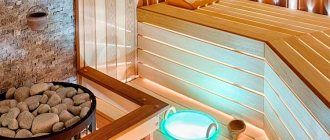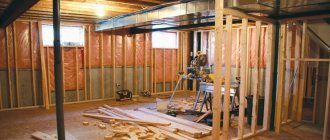Other articles on this topic:
⇒ Installation of a built-in tile shower in a bathroom or toilet
In a house or apartment it is convenient to have a small sauna right in the bathroom. A home mini sauna has the following advantages:
- Allows you to take bath procedures at any time without leaving your home.
- Preparing for work and warming up such a home sauna occurs quite quickly.
- The energy consumption for operating a mini sauna is minimal.
- Building a sauna in the bathroom will cost less
than in any other place. But in an apartment, this is perhaps the only option.
The sauna in the bathroom is a cabin in which the necessary microclimate is created. In the same sauna steam room you can create three different types of microclimate:
- Dry or Finnish sauna
, the air in which is heated to 90-110 oC. Relative humidity at this temperature is approximately 10%. For comparison, in a regular room this figure is usually in the range of 40-60%. High temperature and dry air affect a person in a sauna so that he begins to sweat intensely. - The sauna is wet -
the air is heated only to a temperature of 70-90 oC. But the relative air humidity is higher - 25-40%. To increase humidity, water is poured over hot stones placed in the heater compartment. - Steam sauna (hamam, tilarium) -
the temperature is even lower - less than 60 oC. The air in a steam sauna is saturated with water vapor using a special steam generator. If you add herbal infusions to the steam generator, you can take inhalations in the sauna. The microclimate in the steam sauna is comfortable for everyone, including children.
A steam sauna is also called a Turkish (hamam) or Roman (tilarium) bath. Most people feel comfortable in such a bath at a temperature of about 40 ° C and a relative air humidity of 100%.
Procedures in a steam bath do not put significant stress on the human body. Therefore, a steam sauna can be used by people of all ages, with minimal health restrictions and as often as desired, even every day. In addition, the necessary microclimate in a steam sauna can be created in just a few minutes.
When choosing microclimate parameters in a dry and wet sauna, experts advise adhering to the “rule of 110”. According to this rule, the sum of temperature and relative humidity values should not exceed 110. For example, at a sauna temperature of 65 °C, humidity should not exceed 45%.
Microclimate of an infrared sauna
In recent years, mini sauna cabins with infrared heat sources have appeared on sale and are being actively advertised.
All bodies on Earth are sources of infrared radiation of varying intensities. The higher the temperature of the source, the more energy the rays carry. The most ancient source of powerful infrared radiation that man has learned to use is the flame of a fire. Every person who has taken the “procedure” while sitting by the fire knows that your front burns and your back freezes. Infrared radiation from hot coals has long been used by people to cook food on a grill, grate or spit.
high-temperature heaters with screens that reflect infrared rays towards a person
are used as a heat source In a mini sauna cabin, infrared emitters should be directed at a person from all sides and at all parts of his body. To equip the booth you will need at least 5-6 devices - emitters installed in different places.
The intensity of exposure to infrared rays strongly depends on the distance between the emitter and the human body. The effectiveness of the procedures decreases as the number of people in the infrared sauna cabin increases. People shield each other from the effects of heat rays. The distance from a person to the emitters becomes less than optimal. Individual parts of the body heat up very unevenly. It is better to be alone in the booth.
The air temperature in the infrared mini sauna is maintained at a fairly low 35 - 45 °C. The surface of the human body is heated due to the thermal radiation of infrared emitters directed at it. Similar to how shawarma is cooked on a grill. In such conditions, it is difficult for a person to control the degree of heating of his body. You can easily overheat and even get fried.
Much has been written about the benefits and harms of various types of baths, microclimates and bath procedures among different nations. To decide what suits you, you need to try everything.
Since the infrared bath is a relatively new phenomenon in our country, I will give a review from one who likes to try everything:
“And I think the biggest disadvantage is the time of the procedure. It takes about 30 minutes, although you can endure more, but the body will receive severe stress. And repeated visits are also undesirable. To me, visiting an infrared bath reminds me of receiving a treatment procedure in a physiotherapy room in a hospital.
You cannot take procedures lying down in it! Just sitting!
In addition, in an infrared bath, the color and emotions of a regular bath are completely absent, where you can properly steam yourself with a broom, breathe in the aromas of essential oils and infusions, lie down to rest, and repeat all this as many times as your heart desires, without being limited by time.”
Panel or film cabins - saunas
There are also cabins on sale in which electric heating panels or underfloor heating film are used as heating elements. Sellers call them panel, film or thermal cabins (saunas). Or even infrared saunas.
In panel heating cabins, the temperature of the heaters is low , 60-70 °C. The main heat transfer occurs by convection rather than by infrared rays. The air temperature in the cabin is even lower, and there is no way to change the air humidity.
In real infrared saunas, high-temperature heaters , with a temperature of at least 230-290 ° C. Most of the heat from such heaters is transferred by infrared rays.
The microclimate in panel heating cabins differs significantly from both saunas with a stove and real infrared saunas. The health-improving effect on humans of procedures in such thermal cabins is minimal. Sellers, in order to attract buyers, will tell you tales about miraculous carbon heaters, about the “Rays of Life” or about “resonance absorption”.
Further, infrared saunas and heat cabins are not discussed in this article.
Dimensions and design of a mini sauna
A sauna in the bathroom allows you to take bath and water procedures without much preparation, at any time and without leaving your home.
There are ready-made saunas on sale - cabins that are simply installed in the bathroom. Cabin sizes may vary. In the smallest single or double cabins you can only sit on a bench. It is more comfortable to take bath procedures in cabins measuring 2x1.6 m.
and 2x2
m
.
In such booths you can lie down not alone, but together. The height of the sauna cabin inside should be about 2
m. Inside the cabin there is an electric sauna heater, as well as wooden benches and shelves in two or three levels. The walls and ceiling of the cabin are a three-layer sandwich, which consists of internal wooden panels, mineral wool insulation and external cladding.
Mini sauna in a new house
In a new house, it is convenient to place a mini sauna in a separate room on the floor, in the basement or in the attic.
Anyone who wants to have their own sauna - comfortable, spacious and, above all, functional, should think about it already when ordering a house project or when purchasing finished project.
In a new house, a spacious bathroom is usually provided to accommodate a mini sauna. More comfortable conditions for taking procedures can be created if the sauna is placed in a special fitness room. Exercise equipment or recreational furniture are often installed in the same room. It would be good if this room has access to the garden, terrace or balcony.
To install a mini sauna in a new house, you can provide a separate room in the basement or attic.
Mini sauna in an existing house or apartment
In an existing bathroom, instead of a bathtub, you can install two cabins - a shower and a sauna
Another option for replacing a bathtub in a city apartment with a ready-made cabin is a shower and a sauna together, the size in plan is 200x130 cm.
In an existing house, a sauna can be installed in a large bathroom or, for example, placed in the basement, or one of the rooms can be equipped for this purpose .
The interior panels of the cabin are made from certain types of wood. For example, coniferous wood of northern spruce, fir or cedar releases aromatic substances when heated. But the aroma should be light, there should not be too much of it. Therefore, pine wood, which contains a lot of resins, is not recommended. Panels made of aspen or linden create a more neutral atmosphere in the sauna.
Finished booths are sold disassembled. The booth must be assembled at the installation site. A gap of 20-50 mm is left between the stall and the bathroom wall. for ventilation.
Frame and finishing
The construction material of a traditional bathhouse is logs. However, in winter, a couple of extra fireboxes need to be installed in a classic wood-burning stove in order to first warm up the massive enclosing structures, which are actually blocks of ice in the cold, and only then go into steam mode.
For a home sauna this is not critical, since the log takes up a huge amount of usable space, and not a large bathroom. Therefore, for finishing, an imitation of logs is used - a block house, and the structure itself is constructed using frame technology. The walls, ceiling, and floor are cut off from warm air with reflective and conventional insulation to save money and time.
Rolled thermal insulation has an outer layer of foil that has vapor-proof properties. Therefore, moist air cannot penetrate to the elements of the power frame, and the overall resource of the steam room increases. Additionally, timber, boards and lining are treated with an antiseptic and fire retardant. The first composition protects the wood from rotting, the second prevents fire.
External facades and internal walls of factory mini saunas are finished taking into account classic interior design:
- glass door that easily integrates into tiled walls;
- lining made of juniper (end cut), hemlock, abasha, Canadian/Siberian cedar, linden and alder.
The wood of these species has a high decorative value and, no less important, has low thermal conductivity. That is, touching the cladding and sitting on a shelf decorated with these materials is comfortable, even at extremely high indoor temperatures.
A shower stall is usually made of clear, tinted or frosted glass. Floors in a small room are made of planed boards for loose laying with slots or tongue and groove for end-to-end installation without gaps.
Purchasing ready-made steam rooms provides a number of advantages. First of all, this is high quality assembly, the use of rare, precious wood, and hidden fasteners.
When making a mini sauna yourself, there may simply not be lining of the required wood species on the building materials market. During the cutting and assembly process, the user makes mistakes that are unreasonably expensive or reduce the aesthetics of the perception of the composition as a whole.
How to make a small sauna with your own hands
A sauna measuring 200x160 cm can be placed in a bathroom with an area of 9 m2.
It is cheaper to make a small sauna in the bathroom with your own hands, building it into the room.
The walls and ceiling of the bathroom at the location of the sauna are insulated from the inside with mineral wool on a wall frame. It is more convenient to attach the wooden cladding of the sauna to the wooden crate.
Read: Insulating walls from the inside with mineral wool.
The walls separating the sauna from the rest of the bathroom are assembled on a frame, similar to how they are done when constructing frame partitions. Thermal insulation is also placed in the walls of the cabin.
Read: DIY frame partition.
In order for the sauna to quickly warm up and consume less energy on heating, all heat-intensive surfaces inside the cabin - walls, ceilings made of bricks, blocks, concrete, as well as logs and beams - must be protected with thermal insulation. The thickness of mineral wool thermal insulation is usually 50 mm or 100 mm. for insulating an external wall. For the same purposes, the height inside the sauna should not be more than 2 m
.
For thermal insulation, it is better to use slabs rather than rolled material. Mineral wool boards are denser and less prone to slipping on vertical surfaces.
For a sauna measuring 200x200 cm, a bathroom with an area of 12 m2 is better suited
The insulation from the inside of the sauna is covered with a heat-resistant (with operating temperature above 110 ° C) vapor-proof film laminated with aluminum foil. The film prevents moisture from the insulation and also protects the interior of the sauna from mineral wool dust and other harmful emissions from the insulation. The film is laid on top of the thermal insulation, with aluminum inside the cabin. The joints and places where the film is nailed to the frame are sealed by gluing with aluminum tape - adhesive tape.
On the construction market you can find insulation slabs made of stone wool specifically designed for baths - saunas. Such plates are already covered with aluminum foil on one side. During installation, all seams between the plates and joints are taped with aluminum tape.
In any case, you should choose mineral wool insulation boards that use materials that are harmless to humans as a binder. For example, slabs for facade insulation are usually made using various types of formaldehyde resins as a binder. Such stoves constantly emit the deadly gas formaldehyde. The intensity of gas evolution increases when the material is heated.
Read: Formaldehyde in the house is a source of OSB boards (USB), mineral wool...
The thickness of the wooden cladding inside the sauna (lining, block house) must be at least 12 mm. What type of wood to use for the cladding is written above.
To ensure that the cladding does not darken over time and its appearance remains always attractive, the wood is coated with a liquid heat-resistant compound specifically designed for this purpose. For example, oil based on natural wax “Supi Saunavaha” from Tikkurila.
Wooden elements that are located in areas of lower temperatures, for example, floor gratings, door thresholds, can be protected with ordinary varnish.
The outside of the sauna frame is sheathed with wood, plasterboard or other board material, and lined with ceramic tiles or plastic panels.
Selecting a room
As already mentioned, in apartment buildings it is permissible to install a sauna in the corridors, on balconies and in bathrooms. Basements, storage rooms and attics are excluded due to public importance or the impossibility of complying with technical conditions a priori.
Converting part of a balcony or corridor into a steam zone is extremely labor-intensive and expensive. You will need to install thermal insulation, ventilation, lighting and much more.
A bathroom, isolated or combined with a toilet, already has many important qualities. Bringing it to its final form is much cheaper, faster, and easier. In addition, it is easier to obtain the necessary documentary permits for this premises.
Bath cabin - saunas made of profiled timber or boards
A more expensive sauna option is to make the cabin entirely out of wood.
, without insulation. Walls made of timber do not require additional protection with any films or compounds. Outside, timber walls are decorated with vapor-permeable paints and varnishes.
The walls of the cabin are laid out from thin planed profiled dry timber or boards with a section of 35-70 x 140-180 mm. laid on edge. To seal the joints between the beams, a cord or ribbon made of jute or flax is placed in the groove. A ventilated gap of 20-50 mm is left between the bathroom wall and the timber wall.
It should be noted that the heating time of a sauna made from timber will increase slightly, since the heat capacity of timber, compared to lining, is quite high.
Sauna interior design options
The most common layout options for domestic saunas for use inside an apartment are:
Thus, a mini steam room with a sauna, hammam, bathhouse mode can be assembled on a balcony, in a pantry or bathroom on your own, or you can order the installation of a factory model, taking into account the shape and size of the room.
Advice! If you need bathroom renovation specialists, there is a very convenient service for selecting specialists from PROFI.RU. Just fill out the order details, the experts will respond and you can choose who to collaborate with. Each specialist in the system has a rating, reviews and examples of work, which will help with the choice. Looks like a mini tender. Placing an application is FREE and does not oblige you to anything. Works in almost all cities of Russia.
If you are a master, follow this link, register in the system and be able to accept orders.
How to make a sauna floor
Diagram of the drain into the sewer and the floor of the sauna bath in the bathroom.
Waterproofing layer made of built-up roofing material. In a sauna, it is best to make a concrete floating floor over a layer of extruded polystyrene foam insulation. Ceramic tiles are laid on top of the concrete floor screed.
The sauna floor in the passages is covered with removable wooden gratings. This floor design is not afraid of water and allows for convenient cleaning in the sauna. It will be even more convenient if you install a drain in the floor - a receiving grid with a siphon for draining water into the sewer.
Door to the sauna
The door to the sauna is usually made of wood. Bath doors made of tempered glass are also available for sale. For safety reasons, the door to the sauna should open outward and not have locks, but only latches.
Products for construction and repair
⇆
Sliding doors are convenient - they take up little space when opened, or swing doors that open in both directions. The height of the doors is usually 180-190 cm. The width of the doors varies. The door should not be too narrow - less than 60 cm.
The handles on the door and the handrails inside the sauna are made of wood so that they do not burn your hands.
Shelves and benches in the sauna
Shelves and benches in the sauna are made from wood that does not contain resin - aspen, linden, or from various exotic species that are commercially available. Experts say that products made from these rocks in the sauna are less hot to the touch.
The width of benches and shelves is made in the range of 31 - 55 cm. Benches and shelves are usually arranged in two tiers in height. The vertical distance from the floor to the first tier and between the shelves should be about 40 cm. From the ceiling to the top shelf there should be a distance of 1.2 m. It is recommended to make the top shelf at least 50 cm wide. Shelves and benches should be made of slats, leaving There is a gap of 5-10 mm between adjacent slats. for free air circulation in the mini sauna.
The length of the shelves, for comfortable procedures while lying down, is about 2 m. For ease of cleaning in the sauna, it is better to make the benches and shelves movable - lifting or removable.
It will be more comfortable to sit and the walls of the sauna will remain clean if you install backrests along the shelves and benches on the walls.
Sauna with shower
Combined saunas combine two functional devices - a shower and a bath. They can be presented in two variations.
Sauna with shower
Cabin with steam room option. Devices that look almost no different from ordinary shower stalls: tray, walls, doors, lid. The main feature is that they have a steam generator, which performs the function of a sauna: it evaporates water and brings the steam to a temperature of 50˚C.
Advice. Steam generators are capricious devices that are very sensitive to water quality: if the water is too hard, the steam generator nozzles will quickly become overgrown with salt. That is why it is recommended to use special filters to extend the life of the device.
Combined shower and sauna. In this case, a small but absolutely full-fledged sauna is attached to the cabin. The steam room compartment is usually made of natural wood with low thermal conductivity. This sauna can use both traditional electric heaters and infrared elements.
Electric stove - sauna heater
To heat a mini sauna, the easiest way is to install an electric heater. The power of the stove depends on the size of the sauna.
The power of the electric furnace is selected at the rate of 1-1.5 kW
.
per 1 m2
of sauna area.
For a mini sauna measuring 2x2 m
.
An electric heater with a power of 4-6 kW
. Such a stove can be connected without any problems to the panel at the input of a regular single-phase electrical network of an apartment or house.
The higher the power of the stove, the faster the sauna will heat up. The power of the stove is considered sufficient if the air in the sauna heats up to a temperature of 80 ° C in 20-30 minutes.
An electric sauna stove is usually equipped with a thermostat, which automatically maintains the set temperature in the sauna.
The sauna stove is placed on the floor or on the wall, always near the door
. This arrangement of the oven ensures that the cold air entering through the door is captured by the flow of hot air from the oven, quickly mixed and warmed up. It is convenient to clean the sauna if the stove is mounted on the wall, at a small height from the floor.
It is recommended that the level of the stones in the stove be at the level of the feet of the person sitting on the top shelf. To place the stove at the required height, sometimes it is necessary to build a pit in the floor.
Some furnace designs require guards to be installed around them to protect people from accidentally touching hot parts. It is also necessary to comply with the requirements of the factory fire safety instructions.
The sauna heater stove has a compartment where stones are loaded. The heated stones are watered with water, which turns into steam, increasing the humidity in the sauna.
For laying in the oven, stones with a fraction of 40-80 mm are used. certain minerals, for example, diabase, jadeite, soapstone, etc. Using random stones is dangerous.
Hot stones can crack and fly apart when watered on them. There should not be too many stones, because then the inertia of the furnace increases and, as a result, energy consumption increases.
Experts have calculated that a medium-sized home sauna (200x160 cm
) for one session of bath procedures,
kW*hour
of electricity
for heating . Moreover, most of this energy remains in the house, heating it. For comparison, it takes 1.5 kWh
kWh
to bathe in the bathroom . Most of the energy spent on heating water flows along with the water into the sewer.
For example, one of the domestic manufacturers produces wall-mounted electric heaters under the SteamSib brand. The electric heater is designed to heat and maintain a set temperature in a steam room and generate steam from the stones.
The wall-mounted electric heater “SteamSib” is commercially available in three modifications: with a power of 3.4 kW, 4.4 kW, and 5.4 kW. Dimensions of the electric heater (HxWxD) 506x446x290 mm.
Heating is controlled using a remote control panel. The control panel consists of a control unit and a temperature sensor. The control unit is mounted outside the steam room and connected to the electric heater and temperature sensor mounted inside. The control unit sets the heating level of the steam room and the operating time of the electric heater, and also turns the electric heater on and off.
Types of steam rooms
There are several steam rooms that differ in their healing effect, operating principle, and internal design. Before choosing the type of steam room, you need to study the features of each type.
Infrared
Infrared steam rooms are cabins of different sizes with glass doors trimmed with wood. An IR radiation generator is located inside. Waves warm up the body better than steam.
Infrared steam rooms are safe for the body, since if you choose the right mode, it is impossible to overheat in them. Radiation is not harmful to health.
It is prohibited to use cosmetics in the booth, as they may cause burns on the skin.
Japanese
Ofuro baths are very different from Russian steam rooms and Finnish saunas:
- Visiting a Japanese steam room is a complex process consisting of several sequential procedures.
- Inside there are large barrels with warm water in which visitors warm themselves.
- Warming up should be combined with massage, covering the body with warm sawdust.
Before visiting a Japanese bath, you must undergo a medical examination.
Finnish
The sauna has dry air, minimal humidity, and high temperature. To make a Finnish steam room in an apartment, you need to prepare a large room.
Arranging a sauna with a shower in an apartment is accompanied by difficulties in connecting communications.
Turkish
Most people like hammams due to their mild microclimate. They are characterized by low temperature and high humidity. Steam constantly enters through special channels in the walls. Requirements for arranging a hammam:
- ceilings from three meters high;
- forced ventilation system;
- high-quality vapor barrier.
Hamams are suitable for cosmetic procedures.
Russian
Classic Russian steam rooms are preferred by most bath attendants. They are characterized by low temperature, high humidity, and abundant steam. It is impossible to make a real Russian steam room in an apartment, since it requires a stove that runs on solid fuel.
Electric
A popular option for steam rooms for apartments. They are fireproof because they do not require the use of solid fuel.
The room is heated using an electric stove, which increases energy costs.
Mini
For bathing procedures, a phyto-barrel is used - a container with benches installed inside. In terms of effect and design, the design is similar to ofuro. Before use, the barrel is connected to a regular outlet and filled with water.
Electric steam generator instead of a heater
With a heater stove in the sauna, you can create two microclimate options - a dry or wet sauna.
To create a steam sauna microclimate
It is necessary to additionally purchase a steam generator for the sauna. The steam generator is installed outside and requires connection to a water supply. In the steam generator, water is heated, boils and turns into hot steam, which is supplied through a pipe into the sauna. The tip of the pipe is located in the sauna under the shelves.
heater stoves with a built-in steam generator on sale
For a mini-sauna in the bathroom, a universal device is more suitable - an electric steam generator, with which you can create any type of microclimate in the steam room.
SteamCity (SteamCity) is an electrical device for creating a bathhouse microclimate. Just 3-5 minutes after switching on, the temperature in the steam generation chambers reaches 650 °C and the water coming from the dispenser begins to turn into light, comfortable steam.
An electric steam generator can independently heat small steam rooms (4-8 cubic meters depending on the modification). In addition, it can be used as an addition to the main electric heater in large steam rooms - up to 20 cubic meters.
SteamCity can be used for spa treatments and aromatherapy.
Electric steam generator with a power of 2.6 kW. may be the only heating device for a steam room with a volume of 4 m3 and a power of 5.3 kW. enough to heat a steam room with a volume of 8 m3.
Dimensions of the electric steam generator (HxWxD) 700x400x150 mm.
Lighting in a mini-sauna
In the sauna bath it is necessary to install special waterproof sealed lamps with incandescent lamps. Lights are usually placed high up on the wall in the corners or on the ceiling of the booth.
Sometimes the lamps are installed under the shelves or behind the backrests at a safe distance from the wooden flammable parts of the cabin. It should be borne in mind that this option requires the installation of lamps that are more resistant to water.
Modern energy-saving and LED lamps are not suitable for installation inside a sauna cabin. They are not designed to operate in high ambient temperatures. Such lamps can be installed outside, directing the light inside the booth through the glazing.
Which sauna is best for an apartment?
At first glance, it seems that apartment saunas are not in demand, therefore, the choice is not that big. In fact, thanks to the hot steam and dry heat lovers of the Scandinavian countries, the range of factory models is quite diverse.
Let's start with the fact that all structures can be divided into 3 large groups:
- ready-made prefabricated factory-made models (from lining or panels), with a technical passport, warranty and professional installation;
- frames made to order according to the provided sketch (indicating the dimensions, type of stove, number of seats, etc.);
- buildings made independently according to ready-made or personally drawn up drawings.
The manufacturer is responsible for the operation of the first type along with you, and the remaining two points are solely on your conscience.
If a flood or fire occurs, as a result of which the residents of neighboring apartments suffer, the administrative violation will gradually turn into a criminal case - we advise you to consider all possible risks.
It’s much easier for residents of the private sector - if anyone gets hurt, it’s only the owner of the premises and his family.
Recommendations from professionals are in the following video:
Ventilation in the sauna
| The oven should be located next to the door. The inlet hole is at the bottom, near the floor under the stove. The air outlet is at the top, in the wall or ceiling of the sauna. |
Be sure to arrange ventilation
home sauna.
A hole for air flow is made in the wall of the sauna, below the floor. The inlet opening should be located under the stove or next to it. The hole area is approximately 125 cm2
.
To allow air to escape, another hole is made at the top, in the wall or ceiling of the sauna. The exhaust vent is located as far as possible from the supply vent and from the sauna door. The area of the exhaust opening is twice as large as the supply opening, about 250 cm2
.
The supply and exhaust openings and the sauna door should open into the same bathroom area.
Air circulation from the sauna to the bathroom and back reduces heat loss and helps warm the air in the bathroom.
While the steam room is heating, the ventilation exhaust hole is covered - the sauna will heat up faster. At the end of the procedures, the hole is opened completely to dry the cabin.
The bathroom in which the sauna is located must have an exhaust ventilation duct with access to the street. An electric fan is installed in the exhaust duct .
Read how to properly ventilate your home.
Economy - ventilation channel in the sauna
In order to use the heat of the sauna to heat the house, prudent owners install an economy channel for forced air supply from the bathroom to an adjacent room, for example, to a corridor or hall. Warm air is sucked by a fan into the economy duct from the top of the bathroom and flows down through the pipe, and then exits at floor level in the adjacent room.
The thermostat turns on the fan in the economy channel when the air temperature in the bathroom exceeds the set value. Warm air from the bathroom enters the corridor, hall and then naturally spreads throughout other rooms of the house.
In summer, excess heat from the sauna is utilized by removing warm air to the street through the forced ventilation exhaust duct.
Style and design
The style and design of the steam room, of course, needs to be thought through to the smallest detail. First you need to consider the layout of the room. Typically, a classic version of a steam room is used, consisting of three rooms - a dressing room or locker room, a washing room or shower room, and the steam room itself. Traditional Russian baths usually include two rooms, since the steam room and shower are usually combined. Therefore, when choosing a steam room in the Russian style, you need to take this fact into account. If desired and if you have the money, you can add a number of optional rooms to the sauna. For example, it is possible to equip a font or swimming pool, a game room - a billiard room or similar rooms; you can also add a kitchen, a relaxation area, a restroom or a smoking room.
At the same time, the style of the sauna can also be different. For example, the Russian style, which was already mentioned earlier. He is distinguished by restraint and conciseness in details. As a rule, this is a massive table, many benches and beds, birch brooms, wooden barrels and ladles. Such an interior can be made modern with the help of a billiard table or, for example, a TV.
The antique style is also popular for decorating a steam room. It is often accompanied by forged elements, wooden utensils and other similar items. Also characteristic of this style is the presence of intricate carvings on wooden elements. In addition, you can hang oak or birch brooms on the wall. They can also be represented by fragrant grass. All this can be used in practice and steamed, or saved as decorative elements.
Fire safety requirements for saunas
SP 54.13330.2016 Residential multi-apartment buildings
7.3.14 When designing saunas in apartments of multi-apartment buildings (except for blocked ones), the following should be provided:
- steam room volume - ranging from 8 to 24 m3;
- a special factory-made oven for heating with automatic shutdown when the temperature reaches 130 °C, as well as after 8 hours of continuous operation;
- placing this stove at a distance of at least 0.2 m from the walls of the steam room;
- installation of a fireproof heat-insulating shield over the stove;
- equipping the ventilation duct with a fire damper in accordance with SP 60.13330, SP 7.13130;
- equipment with a deluge or dry pipe connected outside the steam room to the internal water supply.
The diameter of the dry pipe is determined based on the irrigation intensity of at least 0.06 l/s per 1 m2 of wall surface, the angle of inclination of the water jet to the surface of the partitions of 20°-30° and the presence in the dry pipe of holes with a diameter of 3-5 mm, located in increments of 150- 200 mm.
It is recommended that the fire safety requirements outlined above also be followed for saunas located in a private home.
Stages of work
Prefabricated sauna
After all of the above five issues related to the arrangement of the sauna have been fully and efficiently resolved, you can begin the construction process itself.
We are building the frame of the sauna. To do this, we will need wood (timber), a drill, dowels and screws for attaching the timber to the wall, glassine (it will act as an external thermal insulation layer), a tool for working with wood, a building level, a tape measure, and a pencil.
Sauna for a city apartment
The simplest option is to attach the frame beam horizontally directly to the walls of the room allocated for the sauna. In cases where this is not possible (the room is larger than the sauna planned in it), it is necessary to install sufficiently thick wooden spacers between the floor and the ceiling (it is to them that the horizontal timber frame will be attached in the future).
The distance between the timber horizontally fixed to the wall should be as follows:
- 1 row - 3 cm from the floor,
- 2nd row – 60 cm from the floor,
- 3rd row – 1 meter from the floor,
- 4th row - stepping back 5 cm from the ceiling,
- Row 5 – exactly between the 3rd and 4th rows of timber.
Sauna care
Untreated wood deteriorates when constantly exposed to moisture, so when caring for a sauna it is very important that it dry thoroughly after each use.
To keep the sauna clean, after finishing the procedures, while the sauna is still warm, you must:
- wipe the benches and shelves of the sauna with a damp cloth or sponge;
- lift the grate or rug from the floor, lean it against the wall and let it dry;
- remove the remaining water, wipe the floor dry, pick up wet towels;
- open the door and vent.
Under such conditions, a heated sauna will easily dry out, since fresh air, quickly heating up, will take away moisture. This way we will prevent the appearance of mold and mildew, which quickly develop in a warm and humid environment.
Periodically, as the wooden parts of the sauna become dirty, it is necessary to carry out general cleaning. Wash wooden elements with a brush and detergent. Wash off any remaining detergent, wipe with a damp cloth and wipe dry. Then turn on the heater and dry the sauna.
There are also special products on sale for cleaning the internal parts of the sauna, which are also used for disinfection, making it easier to maintain the room.
It is better to cover all wooden surfaces of the sauna with a protective compound (for example, “Supi Saunavaha” from Tikkurila). The composition containing natural wax creates a water- and dirt-repellent surface. Thanks to this coating, wooden surfaces will become less dirty and easier to clean.
The container for stove stones must be cleaned at least once a year. To do this, stones are removed from it, and then fine sand and sediment from water.
More articles on this topic:
⇒ Installation of a built-in tile shower in a bathroom or toilet
More articles on this topic
- Correct sewerage scheme in a private house
- Dew point, vapor barrier and ventilated wall gap
- Air humidifier for apartments and houses - which one is better to choose?
- Ground ventilation heat exchanger in a private house
- Lessons from the Maidan for Russia.
- Solar collector - water heater for home, pool
- DIY broken roof of a house with an attic
- How to properly make natural ventilation in a private house
